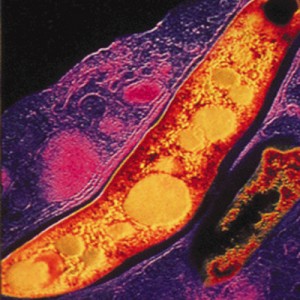Tuberculosis(TB)
Tuberculosis, MTB, or TB (short for tubercle bacillus) is a common, and in many cases lethal, infectious disease caused by various strains of mycobacteria, usually Mycobacterium tuberculosis.[1] Tuberculosis typically attacks the lungs,
but can also affect other parts of the body. It is spread through the
air when people who have an active TB infection cough, sneeze, or
otherwise transmit their saliva through the air.[2] Most infections are asymptomatic
and latent, but about one in ten latent infections eventually
progresses to active disease which, if left untreated, kills more than
50% of those so infected.
One third of the world's population is thought to have been infected with M. tuberculosis,[3] with new infections occurring at a rate of about one per second.[3] In 2007, there were an estimated 13.7 million chronic active cases globally,[4] while in 2010, there were an estimated 8.8 million new cases and 1.5 million associated deaths, mostly occurring in developing countries.[5] The absolute number of tuberculosis cases has been decreasing since 2006, and new cases have decreased since 2002.[5]
The distribution of tuberculosis is not uniform across the globe; about
80% of the population in many Asian and African countries test positive
in tuberculin tests, while only 5–10% of the United States population
tests positive.[1] More people in the developing world contract tuberculosis because of compromised immunity, largely due to high rates of HIV infection and the corresponding development of AIDS.
T-Spot
TB Test.
Spot the hidden danger
T-SPOT. TB assay- Equally useful for
the diagnosis of latent (LTBI) and active TB disease
- T SPOT TB Test has sensitivity of 95.6%.
- T SPOT TB Test uses the RDI antigens, ESAT-6 & CFP 10, which ensure it does not cross react with the BCG vaccine & most environmental mycobacteria.
- T SPOT TB Test has specificity of 97.1%.
- T SPOT TB Test detects extra pulmonary TB.
- T SPOT TB Test is the most accurate test available for the diagnosis of latent TB infections (LTBI).
- T SPOT TB Test is based on pioneering ELISPOT technology- the world’s first and only approved technique to directly measure effector T cell function.
This test is based on the
measurement of effector T-Cells that have been specifically activated against
Mycobacterium Tuberculosis antigens ESAT-6 & CFP 10, eliminates
cross-reactivity to BCG & most environmental mycobacteria. This provides
the T- SPOT. TB test with unique sensitivity & greater specificity.
- US Approved (FDA)
- European Approved (CE)
- Listed in US CDC (Centre for disease Control) guide lines
- Best healthcare innovation award winning technology
- Over 170 published studies
- Has been successfully used all over the world
Signs and symptoms:
About 5–10% of those without HIV, infected with tuberculosis, develop active disease during their lifetimes. In contrast, 30% of those coinfected with HIV develop active disease. Tuberculosis may infect any part of the body, but most commonly occurs in the lungs (known as pulmonary tuberculosis).Extrapulmonary TB occurs when tuberculosis develops outside of the lungs. Extrapulmonary TB may coexist with pulmonary TB as well.General signs and symptoms include fever, chills, night sweats, loss of appetite, weight loss, and fatigue, and significant finger clubbing may also occur.
Pulmonary:
Extrapulmonary:
Active tuberculosis
Diagnosing active tuberculosis based merely on signs and symptoms is difficult,as is diagnosing the disease in those who are immunosuppressed.A diagnosis of TB should, however, be considered in those with signs of lung disease or constitutional symptoms lasting longer than two weeks. A chest X-ray and multiple sputum cultures for acid-fast bacilli are typically part of the initial evaluation.Interferon-γ release assays and tuberculin skin tests are of little use in the developing world.IGRA have similar limitations in those with HIV.
A definitive diagnosis of TB is made by identifying M. tuberculosis in a clinical sample (e.g. sputum, pus, or a tissue biopsy). However, the difficult culture process for this slow-growing organism can take two to six weeks for blood or sputum culture. Thus, treatment is often begun before cultures are confirmed.
Nucleic acid amplification tests and adenosine deaminase testing may allow rapid diagnosis of TB. These tests, however, are not routinely recommended, as they rarely alter how a person is treated. Blood tests to detect antibodies are not specific or sensitive, so they are not recommended.
Latent tuberculosis
Mantoux tuberculin skin test
The Mantoux tuberculin skin test is often used to screen people at high risk for TB.Those who have been previously immunized may have a false-positive test result. The test may be falsely negative in those with sarcoidosis, Hodgkin's lymphoma, malnutrition, or most notably, in those who truly do have active tuberculosis. Interferon gamma release assays (IGRAs), on a blood sample, are recommended in those who are positive to the Mantoux test.These are not affected by immunization or most environmental mycobacteria, so they generate fewer false-positive results. However they are affected by M. szulgai, M. marinum and M. kansasii.IGRAs may increase sensitivity when used in addition to the skin test but may be less sensitive than the skin test when used alone.
Reference :
http://en.wikipedia.org/wiki/Tuberculosis






No comments:
Post a Comment